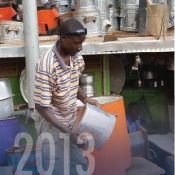Cookstove Distribution Soars; Carbon Finance Now Top Funding Source
The latest results from a global initiative to track the clean stove and fuels market found an all-time high of 14.3 million improved cookstoves distributed in 2013, a 75% jump from the previous year. And in good news for carbon developers pricing remains strong, with the overall price rising a modest 5% to $10.4 per tonne of carbon dioxide equivalent.

12 November 2014 | Last year, when Hillary Clinton announced the Results Report 2012 at the Global Alliance for Clean Cookstoves (“the Alliance”) Leadership Council, she spoke to a crowd including a President, former President, and other notable guests. This year’s report launched quietly online with little fanfare. Though lacking the star-studded attention, the results remain just as important in understanding the latest progress toward ending the four million annual deaths from household air pollution that occur across the globe.
The Results Report 2013 is the second year-long effort by the Alliance to track activities in the improved stoves and fuels market. Like last year, Forest Trends’ Ecosystem Marketplace assisted with this effort. Unlike 2013, Ecosystem Marketplace administered, analyzed and wrote the most recent report.
A total of 456 Alliance partners responded to this year’s survey, up from 246 in 2012, which means that greater insights can be gleaned about market activities. Of particular note are the headline numbers of stoves distributed: an all-time high of 14.3 million stoves were tracked, a 75% jump from 2012 estimates.
However, both the volume and overall value of cookstove project offsets fell by 63%, to 6.3 million offsets worth $61 million. Likewise, the number of stoves distributed with carbon finance dropped from four million last year to one million stoves in 2013. A look beyond 2012 reveals that the 2013 changes still represent a gradual increase from 2008-2011 (Figure 1); meaning that the market should be viewed as cyclic rather than declining.
The 2013 report did feature some good news for carbon finance in that it was the top reported source of funding, edging out government grants. Last year, government grants totaled 36% of all reported finance while carbon finance made up only 6%. This year, the latter jumped to 36% and government grants subsided to 25%.
Another positive outcome for carbon developers is that pricing remains strong, with the overall price rising a modest 5% to $10.4 per tonne of carbon dioxide equivalent (tCO2e). The average voluntary emissions reductions and certified emissions reductions (CER) spot price both rose significantly, to $12.2/tCO2e and $6.4/tCO2e, respectively.
The higher prices found on the voluntary market are reflected in the shift of primary certification types. Last year, over half of cookstoves were developed in compliance with Clean Development Mechanism (CDM) guidelines and only 36% were verified through the Gold Standard (GS) Foundation. This year, GS offsets represented 61% of all transacted volumes, which marks a shift towards targeting voluntary buyers. The CDM made up an additional 37%, with Verified Carbon Standard and dual CDM/GS offsets making up 1% each. While CDM/Joint Implementation (CDM/JI) offsets averaged $6.3/tCO2e, an improvement from 2012, they still don’t match the GS $12.1/tCO2e average.
Despite this shift, compliance markets remain committed to cookstoves. European governments remained willing to pay higher-than-average pricing for cookstove CERs as evidenced by the jump in CER prices. This includes a substantial commitment from the Swedish Energy Agency (SEA) to pay above-average prices for offsets that comply with the Europe Union’s Emissions Trading System (EU ETS). In late 2013, the SEA confirmed two large-scale contracts to deliver 500,000 offsets each by 2020; scales the project developers said were not possible with constrained voluntary market demand.
Luckily for large-scale projects, Sweden is not the only country considering this. The United Kingdom (U.K.) developed the Carbon Market Finance Programme, which will contribute £50 million between 2013-2025 to support greenhouse gas mitigation and renewable energy generation in least developed countries though increased access to carbon finance.
In December 2013, the World Bank’s Carbon Initiative for Development Fund received additional financial support from Sweden, the U.K. and the Swiss-based ClimateCent Foundation in the form of a $125 million pledge. The Fund targets carbon projects that focus on clean energy technologies.
In September, the Nordic Environment Finance Corporation announced a second call for proposals for the Norwegian Carbon Procurement Facility to “prevent the reversal of emission reduction activities by procuring credits from projects whose survival or continued emission reductions depend on a higher carbon price than achievable under current market conditions.
These initiatives reflect the EU ETS’s new regulation beginning in 2013, which requires compliance buyers to purchase any new CERs from Least Developed Countries (LDCs). Unsurprisingly, Africa, home to the most LDC countries, provided 78% of all carbon offsets. Asia and Latin America snagged an equal share of the rest, with 12% and 10%.
Kelley Hamrick is an Associate in Ecosystem Marketplace’s Carbon Program. She can be reached at [email protected].
Please see our Reprint Guidelines for details on republishing our articles.


